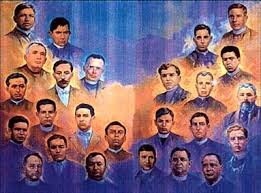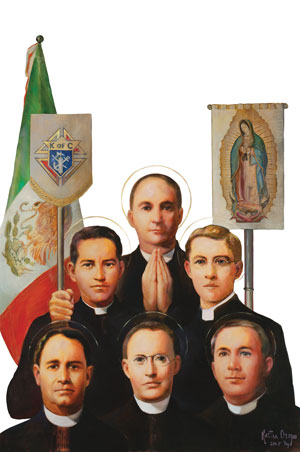Servant of God Fr Hernando de Santaren & Companions, SJ
Martyrs of Mexico
Died: November 16 to 20, 1616
 The lives of eight Jesuit priests came to an abrupt and when they were martyred by the Tepehuan Indians living in northwestern Mexico (today’s Durango) between November 16 and 20, 1616. Some of the Tepehuan had been converted to Christianity by Fr Jerome Ramirez, SJ who came earlier in 1596 and had by 1597, established three villages, Santiago Papasquiaro, Santa Catalina, and Guanacevi. With more conversions, more villages were added to its number. All was peaceful as the missionaries devoted themselves to teach the native population the fundamentals of the Catholic faith, how to cultivate the land and grow crops, and build homes, leaving the Indians to govern the village.
The lives of eight Jesuit priests came to an abrupt and when they were martyred by the Tepehuan Indians living in northwestern Mexico (today’s Durango) between November 16 and 20, 1616. Some of the Tepehuan had been converted to Christianity by Fr Jerome Ramirez, SJ who came earlier in 1596 and had by 1597, established three villages, Santiago Papasquiaro, Santa Catalina, and Guanacevi. With more conversions, more villages were added to its number. All was peaceful as the missionaries devoted themselves to teach the native population the fundamentals of the Catholic faith, how to cultivate the land and grow crops, and build homes, leaving the Indians to govern the village.
The Tepehuan rebellion of 1616 had religious and political undertones. Though the Indians were converted; some could not totally withdraw themelves from the influence of their medicine men, one of whom, Quautlatas, an apostate convert, was said to be the revolt’s leader. Seeing his power diminishing with the coming of the missionaries, his chief opponents, Quautlatas appealed to the nationalist spirit of the Tepehuan and urged them to cast out the foreigners, missionaries and Spaniards alike, so that the tribe could regain their freedom and many found this appealing.
The rebel plan was to attack the village of San Ignacio del Zape on November 21, 1616, the feast of the Presentation of Our Lady, when the missionaries would all be present for the blessing of a new statue of our Lady. Many Spaniards would also be there and since it was a religious festival, they would be unarmed ensuring the Indians a quick and easy victory. This plan never saw fruition for the uprising was prematurely ignited ahead of time.
 The first of the eight Jesuits to die was Fr Hernando de Tovar, a native Mexican. He was born in the Spanish colony of San Miguel de Culiacan in western Mexico in 1581, and had as a youth come into contact with the many Jesuits who came to stay at his parents’ home when they visited the city. He helped to take care of Fr Hernando de Santaren who lived with the Tovar family for several months when he became ill in 1594. Neither knew that twenty-two years later they would be martyred for the same cause. Hernando entered the Jesuit novitiate at Puebla on August 10, 1598 and was probably ordained after his studies in Mexico City in 1608.
The first of the eight Jesuits to die was Fr Hernando de Tovar, a native Mexican. He was born in the Spanish colony of San Miguel de Culiacan in western Mexico in 1581, and had as a youth come into contact with the many Jesuits who came to stay at his parents’ home when they visited the city. He helped to take care of Fr Hernando de Santaren who lived with the Tovar family for several months when he became ill in 1594. Neither knew that twenty-two years later they would be martyred for the same cause. Hernando entered the Jesuit novitiate at Puebla on August 10, 1598 and was probably ordained after his studies in Mexico City in 1608.
Though an exceptional preacher, he preferred to minister to native peoples and thus was sent to the Parras mission where he laboured for seven years. Shortly before the rebellion, he visited Culiacan and on his return stopped at the Tepehuan mission of Santa Catalina. That same evening a muleteer, leading a train of mules heavily-laden with clothing and merchandise for a nearby wealthy mining district, also stopped for the night in the village. The next morning, the Indians, consumed with greed for the muleteer’s cargo, decided to advance the uprising by robbing and killing him. When the Indians saw Fr Tovar setting off to his mission, they feigned friendship by offering grain to his mule. Then one of the rebels hit the priest’s head with a blow which knocked him to the ground and while helpless another thrust a lance into his breast and killed him.
Fr s Bernard de Cisneros and Diego de Orozco were the next two Jesuits to be martyred.
Fr Cisneros, a Spaniard, was born in 1582 in Carrion de los Condes, near Palencia, Spain. He entered the novitiate at Villagarcia on March 21, 1600. After three of studies he was sent to the Mexico mission in 1605 and there completed his preparation for the priesthood. By 1610 he was at Santiago Papasquiaro working among the Tepehuan.
Fr Orozco, a Spaniard was born in 1588 in Plasenia de Estremadura, Spain. He entered the novitiate at Villagarcia on March 19, 1603. He accompanied Fr Cisneros to Mexico in 1605 and was ordained in 1614. He worked as the latter’s assistant from 1615.
Both Frs Cisneros and Orozco heard rumours of a possible uprising and brought this to the attention of the Papasquiaro chief who together with three aides went to seek out the rebels to negotiate peace on November 15. However all the four were brutally murdered. When the villages heard this and that some 200 Indians were marching toward them, they sought refuge in their church, the only sturdy building in the compound. From 16 to 18 November the rebels tried to force their way into the church, but without success.
On the 18th, Fr Cisneros, seeing the church besieged by 500 rebels, decided to sue for peace. As he opened the church door, he met with a shower of arrows that wounded him. The rebels asked those inside the church to lay down their arms and come out offering them peace and claiming they too were Christians. Thinking they were indeed Christians, those within emerged in solemn procession together with the Blessed Sacrament. The rebels initially showed reverence hypocritically for the Sacrament, but when all were clearly in the open they fell upon the innocent victims. One of them grabbed the Blessed
Sacrament from Fr Cisneros’ hands and trampled the hosts to the ground; another pierced him with a lance and the third killed him with a blow to the head. Fr Orozco received an arrow in his chest and his body was cut in two with an axe.
Frs John del Valle and Louis de Alaves, stationed at Zape were the next two to die for their faith on November 18.
Fr Valle, a Spaniard, was born in Vitoria, Spain on October 22, 1575. He entered the Society at Villagarcia on April 21, 1591 and sailed to Mexico in He studied in Mexico City and was ordained in 1602. In 1604 he began working among the Tepehuan and laboured for twelve years.
Fr Alaves, a native Mexican, was born in Tequisistlan (today’s Oaxaca), Mexico. On January 29, 1589. He entered the Jesuit Novitiate at Tepotzotlan on May 21, 1607. After his ordination in 1614 he was assigned to assist Fr Valle at Zape.
Fr Valle had invited other Jesuit missionaries and many Spaniards to come for the November 21 feast which was to be a great festival and many Indians were already in the village preparing for that big day. On the morning of November 18, some of the rebels who had taken part in the massacre at Santa Catalina on the 16th, took the villages at Zape by surprise. They arrived just as the Frs Valle and Alaves entered the church to celebrate Mass. Hoping to talk peace with them, both priests came out of the church, with Fr Valle carrying the statue of Our Lady and Fr Alaves one of Our Lord. But before they were a few paces outside, both were brought down and urdered. The rebels then went on to massacre the Zape Christians.
On November 19, Frs John Fonte and Jerome de Moranta were the next two Jesuits to be martyred.
Fr Fonte, a Spaniard was born in Villa de Tarraza, near Barcelona, Spain, on August 20, 1574. He entered the Society at Saragossa on April 7, 1593 and was ordained in Barcelona and in 1599 went to the Mexico and was assigned to the Tepehuan mission. He soon mastered the their language and prepared a dictionary, grammar, and a catechism for the use of other missionaries. When the rebellion began, he was at Ocatlan with his companion of ten years, Fr Jerome de Moranta.
Fr Moranta, a Spaniard was born in Palma, Majorca, in 1574 and had entered the Society in 1595. He arrived in Mexico in 1605. Since both Frs Fonte and Moranta planned to be at Zape for the celebrations on Nov 21, they left their mission on the 19th, and not far from
their station they unexpectedly encountered the rebels, who shot arrows into their hearts and clubbed them to death.
Fr Hernando de Santaren, the last Jesuit to be martyred was the oldest of the eight and the most experienced having spent twenty-two years ministering to the native peoples of Mexico. He was born at Huete (today’s Cuenca), Spain, in February 1567. He entered the Society at Villarejo de Fuentes in October 1582. He was in Mexico by October 1588 and after completing his theological studies he was ordained on March 19, 1593. During his two decades on the mission, he had been stationed in various villages and had evangelized several different tribes.
During his first assignment to Mocorito in 1594 his health failed and for several months he was residing with Fr Hernando de Tovar’s family until he was able to resume work and went on to work among several tribes. On 19th while he was on his way to his next mission to evangelise to the Nebones natives living in northern Mexico and planned to stop at Zape for the festivities. However on November 20 he came upon a village that was totally deserted. He entered the church and found the altar in ruins; he rang the church bell but no one came. He had not as yet heard of the uprising and the massacres in the several villages. He mounted his mule and cautiously took the road to Santiago Papasquiaro. On the road he met a band of rebels Indians and they soon surrounded him. Amid shouts of joy they knocked him from his mule and with a club, struck his head so that his brains spewed forth onto the ground. They then stripped his body and threw it in to the river.
With the insurrection and the martyrdom of these missionaries, the Jesuit Tepehuan mission came to an end. The cause of these 8 Jesuits is presently under study.
